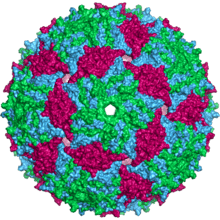Leviviridae
Leviviridae is a family of viruses. Bacteria, including Enterobacteria, Caulobacter, Pseudomonas, and Acinetobacter serve as natural hosts for these bacteriophages. There are currently four species in this family, divided among 2 genera.[1][2] They are small RNA viruses with linear, positive-sense, single-stranded RNA genomes that encode only four proteins. All phages of this family require bacterial pili to attach to and infect cells.[3]

| Leviviridae | |
|---|---|
| Virus classification | |
| (unranked): | Virus |
| Realm: | Riboviria |
| Kingdom: | Orthornavirae |
| Phylum: | Lenarviricota |
| Class: | Allassoviricetes |
| Order: | Levivirales |
| Family: | Leviviridae |
| Genera | |
Taxonomy
The family has two genera, both of which currently have two known species.
Group: ssRNA(+)
- Family: Leviviridae
- Genus: Allolevivirus
- Escherichia virus FI
- Escherichia virus Qbeta
- Genus: Levivirus
- Escherichia virus BZ13
- Escherichia virus MS2
Structure
Viruses in Leviviridae are non-enveloped, with icosahedral and Spherical geometries, and T=3 symmetry. The diameter is around 26 nm. Genomes are linear and non-segmented, around 4kb in length. The genome codes for 4 proteins.[1]
| Genus | Structure | Symmetry | Capsid | Genomic arrangement | Genomic segmentation |
|---|---|---|---|---|---|
| Levivirus | Icosahedral | T=3 | Non-enveloped | Linear | Monopartite |
| Allolevivirus | Icosahedral | T=3 | Non-enveloped | Linear | Monopartite |
Life cycle
Entry into the host cell is achieved by adsorption into the host cell. Replication follows the positive stranded RNA virus replication model. Positive stranded RNA virus transcription is the method of transcription. Translation takes place by suppression of termination. The virus exits the host cell by bacteria lysis. Enterobacteria, caulobacter, pseudomonas, and acinetobacter serve as the natural host.[1]
| Genus | Host details | Tissue tropism | Entry details | Release details | Replication site | Assembly site | Transmission |
|---|---|---|---|---|---|---|---|
| Levivirus | Enterobacteria | None | Pili | Lysis | Cytoplasm | Cytoplasm | Contact |
| Allolevivirus | Enterobacteria | None | Pili | Lysis | Cytoplasm | Cytoplasm | Contact |
Genome
The four proteins encoded are the coat, replicase, maturation and lysis proteins.[3]
References
- "Viral Zone". ExPASy. Retrieved 15 June 2015.
- ICTV. "Virus Taxonomy: 2014 Release". Retrieved 15 June 2015.
- Bollback, JP; Huelsenbeck, JP (February 2001). "Phylogeny, genome evolution, and host specificity of single-stranded RNA bacteriophage (family Leviviridae)". Journal of Molecular Evolution. 52 (2): 117–28. Bibcode:2001JMolE..52..117B. doi:10.1007/s002390010140. PMID 11231891.